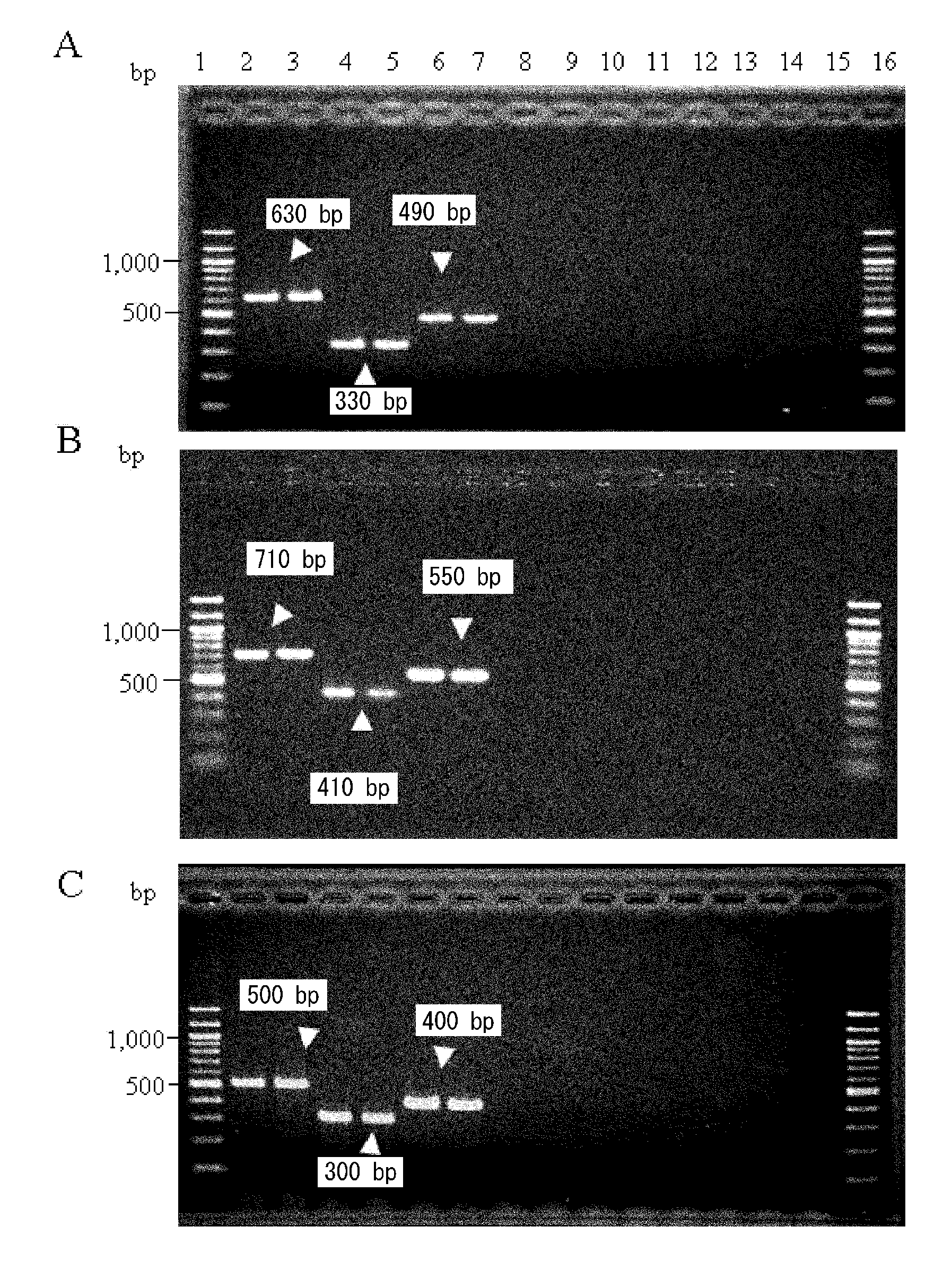Detection Of Bacteria Belonging to the Genus Campylobacter By Targeting Cytolethal Distending Toxin
a technology of cytolethal distending toxin and detection method, which is applied in the field of detection methods of campylobacter bacteria, can solve the problems of mass outbreak of food poisoning, infertility, and inability to detect bacteria, and achieves the effects of miscarriage, and reducing the number of infertility
- Summary
- Abstract
- Description
- Claims
- Application Information
AI Technical Summary
Benefits of technology
Problems solved by technology
Method used
Image
Examples
example 1
Multiplex PCR for cdt Genes
[0183]For positive control, bacterial species-specific fragments of about 630 bp, 330 bp, and 490 by were amplified by multiplex PCR for the cdtA gene in C. jejuni, C. coli, and C. fetus, respectively. As in the case of positive control, bacterial species-specific fragments of about 710 bp, 410 bp, and 550 b were amplified by multiplex PCR for the cdtB gene in C. jejuni, C. coli, and C. fetus, respectively. Furthermore, as in the case of positive control, bacterial species-specific fragments of about 500 bp, 300 bp, and 400 by were amplified by multiplex PCR for the cdtC gene in C. jejuni, C. coli, and C. fetus, respectively (FIG. 1). Meanwhile, none of the cdtA, cdtB, and cdtC genes was amplified in other cdt gene-positive Campylobacter bacteria such as C. hyointestinalis C. lari, C. upsaliensis, and C. helveticus; H. hepaticus, Haemophilus ducreyi (H. ducreyi), A. actinomycetemcomitans, and Shigella spp.; and E. coli having five different types of cdt ge...
example 2
Detection of Campylobacter Bacteria Using Common Primers for the cdtB Gene
[0184]Common primers targeting the cdtB gene, which has the highest homology between the bacterial species, were designed and used to assess whether Campylobacter bacteria can be detected by a single round PCR targeting the cdt gene. PCR using the common primers yielded bands of about 720 by that are specific to the cdtB genes of C. jejuni, C. coli, and C. fetus. Furthermore, a fragment of about 720 by was also amplified in other Campylobacter bacteria, specifically C. hyointestinalis, C. lari, C. upsaliensis, and C. helveticus, in addition to C. jejuni, C. coli, and C. fetus (FIG. 2). The nucleotide sequences of the obtained PCR products of Campylobacter bacteria other than C. jejuni, C. coli, and C. fetus were determined, and the result showed that each of them has a gene highly homologous to the cdtB gene of C. jejuni. Meanwhile, no fragment was amplified by the common primers in non-Campylobacter cdt gene-...
example 3
Simultaneous Detection of Different Campylobacter Bacteria by Multiplex PCR Targeting the cdtB Gene
[0185]Under the assumption of mixed infection, it was assessed whether multiplex PCR targeting the cdtB gene can simultaneously detect different bacterial species of Campylobacter. In the previous Example, the multiplex PCR targeting the cdtA, cdtB, and cdtC genes was demonstrated to be specific to each of them. Since the cdtB gene was found to be most highly conserved among these subunit genes, multiplex PCR targeting the cdtB gene was used in the subsequent experiments.
[0186]Multiplex PCR targeting the cdtB gene was carried out by mixing two or three of the genomic DNA of C. jejuni, C. coli, and C. fetus. As shown in the result of FIG. 3, specific bands for each species could be amplified not only when C. jejuni, C. coli, and C. fetus were present separately but also when two or three of them are present in mixture. Accordingly, multiplex PCR targeting the cdtB gene is expected to be...
PUM
| Property | Measurement | Unit |
|---|---|---|
| Volume | aaaaa | aaaaa |
| Angle | aaaaa | aaaaa |
| Angle | aaaaa | aaaaa |
Abstract
Description
Claims
Application Information
 Login to View More
Login to View More - R&D
- Intellectual Property
- Life Sciences
- Materials
- Tech Scout
- Unparalleled Data Quality
- Higher Quality Content
- 60% Fewer Hallucinations
Browse by: Latest US Patents, China's latest patents, Technical Efficacy Thesaurus, Application Domain, Technology Topic, Popular Technical Reports.
© 2025 PatSnap. All rights reserved.Legal|Privacy policy|Modern Slavery Act Transparency Statement|Sitemap|About US| Contact US: help@patsnap.com



